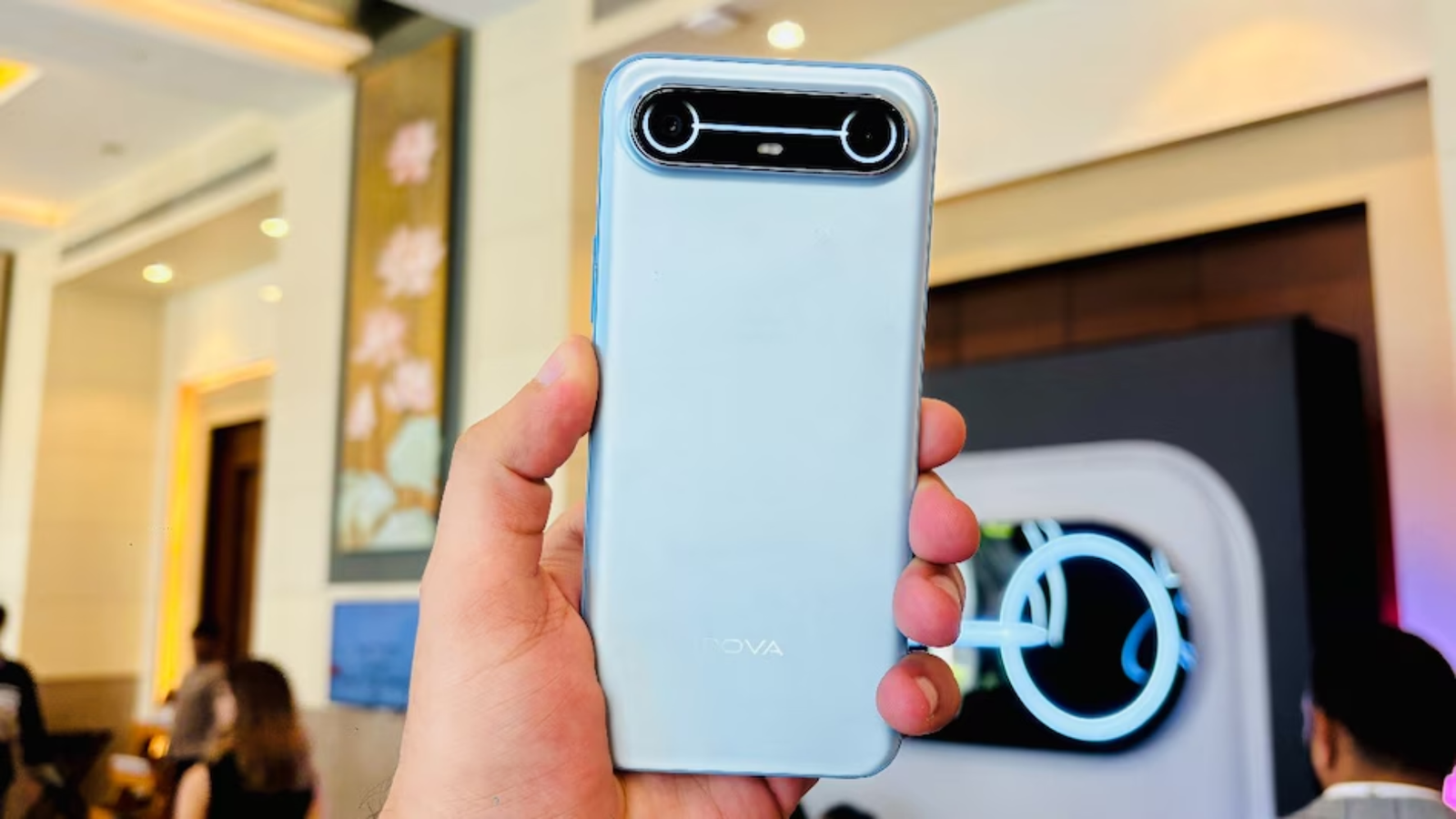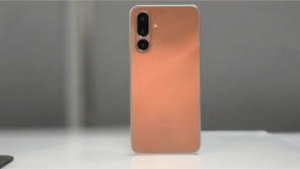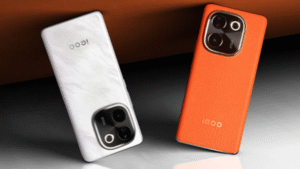Tecno Pova Slim 5G Review: The Tecno Pova Slim 5G is Tecno’s bold entry into the mid-range smartphone market, launched in September 2025 and priced at just Rs 19,999 for the 8GB RAM + 128GB storage version. This phone grabs attention as one of the world’s slimmest 5G devices at only 5.95mm thick, promising a premium feel without the premium price tag.
It’s aimed at users who want a lightweight, stylish gadget for daily tasks like browsing, streaming, and light gaming. However, while it shines in design and battery endurance, a key drawback in long-term software updates might make you think twice. In this straightforward review, we’ll cover its build, screen, speed, cameras, power source, and more based on real-world testing. If you’re eyeing budget phones under Rs 20,000 like the Realme Narzo 70 or Moto G85, the Pova Slim 5G stands out for its unique looks but needs to deliver on performance to compete.
Design and Build: Ultra-Thin and Eye-Catching
The Pova Slim 5G feels like a high-end phone in your hand, thanks to its super-slim 5.95mm thickness and feather-light 156g weight. Measuring 164.23 x 75.91 x 5.95mm, it’s tall and narrow, making it easy to grip for one-handed use during calls or quick scrolls. The back and sides are made of sturdy polycarbonate plastic with a matte finish that resists fingerprints better than glossy rivals, though it can feel a bit slippery without a case.
It comes in three cool colors: Cool Black, Sky Blue, and Slim White, with the blue option giving a calm, modern vibe. The rear has a unique vertical dual-camera visor – a slim module that pops out robotically for a futuristic touch – surrounded by a Dynamic Mood Light ring. This LED circle glows in patterns for alerts like low battery or incoming calls, but you can only pick from three basic styles. An infrared (IR) blaster on top lets you control TVs or ACs like a remote.
The bottom edge has a speaker grille, SIM tray, mic, and USB Type-C port for charging. Power and volume buttons are on the right, keeping the left side clean. It holds up with an IP64 rating against dust and splashes, plus military-grade drop protection (Mil-810H). A curved tempered glass protector comes in the box, which is a nice bonus for the bendy screen. While the plastic build isn’t as fancy as metal or glass, it’s tough for everyday bumps – just be gentle, as the thin frame might flex under heavy pressure.
Display: Vibrant and Smooth for Media Lovers
The 6.78-inch curved AMOLED screen is a real standout, offering full HD+ resolution (1,224 x 2,720 pixels) for sharp details in photos and videos. With a 144Hz refresh rate, scrolling through apps or social feeds feels silky smooth, like gliding on ice. Colors are punchy and lifelike, with deep blacks and high contrast perfect for Netflix binges – it even supports Widevine L1 for HD streaming.
Brightness hits up to 4,500 nits in auto mode, so you can see clearly even in harsh sunlight. The curved edges add a premium, immersive touch for gaming or movies, protected by Gorilla Glass 7i against scratches. Preset modes let you tweak colors if they’re too bold, and the always-on display shows quick info without wasting power. The in-display fingerprint scanner works fast but can lag slightly with wet fingers. Thin bezels make it look modern, though the punch-hole selfie camera notch takes a bit of space from the top. For under Rs 20,000, this screen rivals pricier phones and makes casual viewing a joy.
Performance: Handles Basics Well, But Lags in Demands
At its core, the Pova Slim 5G uses the MediaTek Dimensity 6300 chipset – a budget 5G processor on a 6nm process – paired with 8GB LPDDR4X RAM and 128GB UFS 2.2 storage. It zips through simple stuff like WhatsApp, YouTube, or web surfing without hiccups, and multitasking with 10-15 apps stays smooth. In benchmarks, it scores around 400,000 on AnTuTu, solid for the price.
Light games like Candy Crush or Subway Surfers run flawlessly, and even BGMI at medium settings holds steady for short sessions. But heavier titles like Genshin Impact cause warming after 30 minutes and frame drops. No microSD slot means you’re stuck with 128GB (about 100GB usable), which fills up fast with videos or apps. The “Intelligent Signal Hub” boosts 5G in weak areas, but it’s Tecno-exclusive.
Stereo speakers with Dolby Atmos pump out loud, clear sound for music or calls. It’s fine for students or commuters, but power users might notice it slowing down over time.
Tecno Pova Slim 5G Key Specifications Table
Here’s a quick table of the main features for easy scanning:
| Feature | Details |
|---|---|
| Display | 6.78-inch Curved AMOLED, FHD+, 144Hz, 4,500 nits, Gorilla Glass 7i |
| Processor | MediaTek Dimensity 6300 (6nm) |
| RAM/Storage | 8GB LPDDR4X RAM, 128GB UFS 2.2 (no expandable) |
| Rear Camera | 50MP main + 8MP ultrawide |
| Front Camera | 32MP |
| Battery | 5,100mAh with 33W fast charging |
| OS | Android 14 with HiOS 14 (2 years OS updates) |
| Build | IP64 dust/splash resistant, 156g, 5.95mm thick |
| Other Features | IR blaster, Dynamic Mood Light, stereo speakers with Dolby Atmos |
| Colors | Cool Black, Sky Blue, Slim White |
| Price (Starting) | Rs 19,999 |
Camera Setup: Decent Day Shots, Struggles at Night
The dual rear cameras include a 50MP main sensor for crisp daytime photos with natural colors and good detail in bright light. Optical image stabilization (OIS) keeps shots steady, even if your hand shakes. The 8MP ultrawide lens captures broad views like landscapes without much warping. Videos hit 4K at 30fps with okay stabilization for casual clips.
The 32MP front camera shines for selfies, with AI beauty modes for smooth skin and group shots. However, low-light performance is average – Night mode helps, but photos get noisy and lose sharpness after sunset. The ultrawide darkens edges in dim conditions. AI tools like scene detection add fun filters, but it’s not pro-level. For social media snaps, it’s reliable; for serious photography, look elsewhere.
Battery and Charging: A True All-Day Champ
The 5,100mAh battery is the phone’s hero, lasting up to 14-16 hours of mixed use – think 7 hours of screen time with streaming, calls, and browsing. It barely sips power in standby, easily surviving a full day for moderate users. The 144Hz screen doesn’t drain it much, thanks to smart optimization.
33W fast charging fills it from 0-100% in about 65 minutes, and a charger is included – a rarity these days. No wireless charging, but reverse charging powers earbuds in a pinch. It’s a win for travelers or busy folks who hate hunting for outlets.
Software: Clean Start, But Short Update Life
Running Android 14 with Tecno’s HiOS 14 skin, the interface is simple and customizable, with minimal bloatware. Features like app cloning (run two accounts) and gesture controls add convenience. However, the major catch: only two years of OS upgrades and three years of security patches. In 2025, this lags behind Samsung or Google phones offering four to seven years, meaning quicker obsolescence and security risks.
Conclusion
The Tecno Pova Slim 5G nails the slim, stylish vibe with a stunning curved display and unbeatable battery life that keeps you going all day. At Rs 19,999, it’s a fun choice for casual users who prioritize looks and endurance over raw speed. But the outdated chipset, limited storage, and skimpy software support are big letdowns – especially when cheaper phones match its performance. If you’re okay with short-term use, snag it on Flipkart for the design alone. Otherwise, consider rivals with better longevity. It’s got potential, but needs more substance to truly slim down the competition!
FAQ
1. What is the price of the Tecno Pova Slim 5G?
It starts at Rs 19,999 for the 8GB + 128GB variant in India.
2. How thin is the Tecno Pova Slim 5G?
It’s an ultra-slim 5.95mm thick, making it one of the world’s thinnest 5G phones.
3. Does the Pova Slim 5G have expandable storage?
No, it’s limited to 128GB internal storage with no microSD card slot.
4. How long does the battery last?
The 5,100mAh battery offers up to 14-16 hours of mixed use, easily a full day.
5. What software updates does it get?
It runs Android 14 with HiOS 14 and promises only two years of OS updates.




